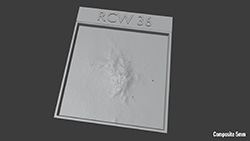CXC Home | Search | Help | Image Use Policy | Latest Images | Privacy | Accessibility | Glossary | Q&A
1
X-ray & Infrared Images of RCW 36Credit: X-ray: NASA/CXC/Ames Research Center/L. Bonne et al.; Infrared: ESA/NASA.JPL-Caltech/Herschel Space Observatory/JPL/IPAC
A study of RCW 36, a large cloud of ionized hydrogen, shows that stars in a cluster can limit how many new stars form when the biggest and brightest members expel most of the gas from the system, thus drastically slowing down star birth. These images of RCW 36 include X-rays from Chandra and infrared data from Herschel. Data from the SOFIA and APEX telescopes were also used in the study. The X-rays from Chandra reveal very hot gas near the center of the cluster and near the edges of the image.
2
3D Printable Files: RCW 36 Tactile Plate (3D Print Credit: NASA/CXC/A. Jubett, using software by Tactile Universe/N. Bonne & C. Krawczyk & Blender)
RCW 36 is a region of star formation about 2,900 light-years from Earth. This tactile plate depicts RCW 36 as a physical relief map based on the intensity of X-ray data captured by Chandra and infrared data from Herschel. The file for this plate can be downloaded and 3D-printed for learners to touch.
The plate depicts a large hot gas cloud flecked with dots, where the dots are new stars, a major source of the region’s hot gas. At our lower left and upper right are two large cavities, or voids, carved out of the gas. In the center of the image is a ring of gas wrapping around the central star cluster.
The plate depicts a large hot gas cloud flecked with dots, where the dots are new stars, a major source of the region’s hot gas. At our lower left and upper right are two large cavities, or voids, carved out of the gas. In the center of the image is a ring of gas wrapping around the central star cluster.
Return to: Astronomers See Stellar Self-Control in Action (November 29, 2022)











